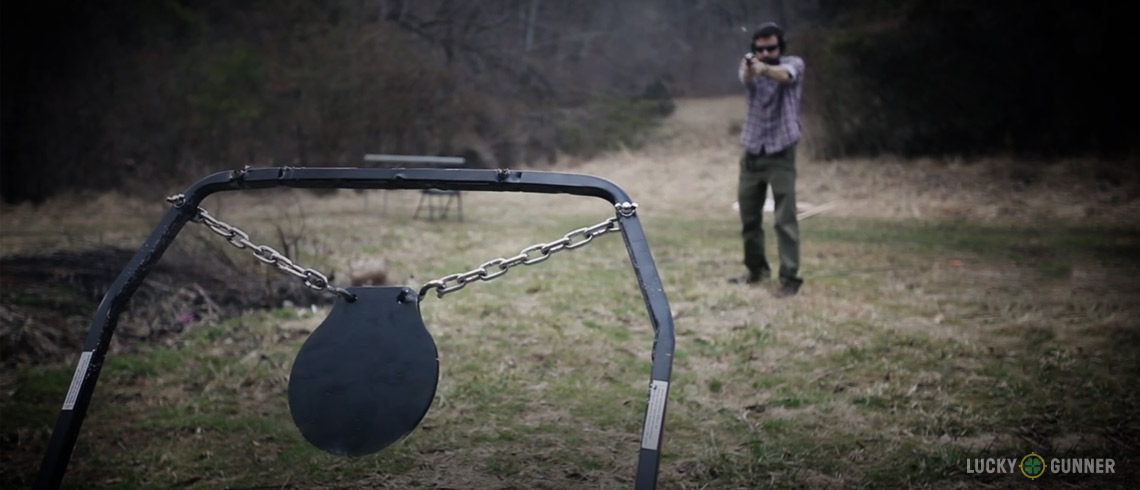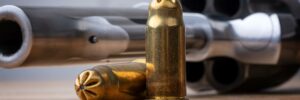Shooting Steel Point Blank? No Problem.
Statistically speaking, recreational shooting is one of the safest hobbies you can participate in. This is partly due to the fact that, as a shooting community, we all observe more or less the same basic safety rules which are mostly designed to keep anyone from getting unnecessarily shot.
However, there are other risks involved in shooting that don’t get quite as much attention, like ricochets and lead exposure. These are two of the problems solved by shooting frangible ammo.
What is Frangible Ammo?
Frangible ammunition is no different than normal target ammo except the bullet. Instead of a lead core with a copper jacket, frangible bullets are made from compressed copper powder. Whenever the bullet strikes something harder than itself at full speed, it crumbles to pieces. Still dangerous if you’re standing on the wrong side of the muzzle, but once they hit a hard target, the bullet fragments are too small to cause any harm from ricochets. That also means there’s reduced risk of damage to steel targets themselves from frangible ammo.
This even works for frangible rifle loads, which we got to see in action at SHOT show this year. Sinterfire makes about 90% of the bullets that go into frangible loads in the U.S. and they invited us to check out a demo of their products, which you can see in the video above. If you’re curious, you can get a good look at SinterFire’s 9mm ammo here and their .45 ACP lead-free rounds here.
The Sinterfire guys were also quick to point out that their ammo is just about the cleanest you can shoot. With no lead in the projectile, there’s no airborne lead released when the bullet leaves the barrel. On top of that, Sinterfire’s Greenline ammo also uses a non-toxic primer, so there’s virtually nothing harmful released into the air. Well… nothing harmful except the bullet, but only if you get shot with one.
Sinterfire also has a really cool promo video. It’s produced by the same guys who did all the eye candy super slow motion work on Top Shot and you should check it out.




Could you use did as a self defense ammo, and what would the damage do to a person?
interesting
We used frangible rounds to put down rabid or injured animals in an urban environment. Did the job without having to worry about ricochets.
Could you use did as a self defense ammo, and what would the damage do to a person?
I belive so as long as the person isn’t made out of steel. I think you would be better with hallow points though to not risk over penetration. I’m guessing these would keep going untill something stopped it.
Sinterfire does market these as potential self-defense loads, though I don’t know how effective they would be compared to more conventional hollow points. They will penetrate and almost immediately start to fragment in a human or animal, but many of the fragments will be very small. Sinterfire has photos/video of their ammo in ballistics gel on their website and YouTube channel.
interesting
We used frangible rounds to put down rabid or injured animals in an urban environment. Did the job without having to worry about ricochets.
Ricochets?! Are you placing the animals in front of angled steel walls?? lol..
I think it is confusing ammunition. I don't use steel targets. I tried some real targets in life to see what effect there would be with frangible ammo (International 9mm 100gr.) I had two rounds go through 3 layers of 1/2" sheet rock, 4 layers of 1/2 inch plywood, and a piece of 3" seasoned oak timber.. and the bullet was still going when it hit the backstop of concrete block! I don't think this does what I expect. I would have expected the penetration of the sheet rock and plywood, but not the continued penetration of seasoned oak. I conclude that this ammo is for steel targets, otherwise, it will continue through just about anything or anybody…
the vidoes wont play for me
I think it is confusing ammunition. I don’t use steel targets. I tried some real targets in life to see what effect there would be with frangible ammo (International 9mm 100gr.) I had two rounds go through 3 layers of 1/2″ sheet rock, 4 layers of 1/2 inch plywood, and a piece of 3″ seasoned oak timber.. and the bullet was still going when it hit the backstop of concrete block! I don’t think this does what I expect. I would have expected the penetration of the sheet rock and plywood, but not the continued penetration of seasoned oak. I conclude that this ammo is for steel targets, otherwise, it will continue through just about anything or anybody…
Those results aren’t too surprising, Joe. The frangible bullets will break up when then hit something as hard or harder than themselves. Otherwise, they are designed to work like normal bullets, so they will still penetrate soft targets.
LG Chris ,
Thanks very much. I would not consider these rounds to be appropriate for self-defense. It would certainly lead to over penetration. If it would not fragment in three inches of seasoned oak wood, there in nothing in the body that is going to be hard enough to create fragmentation. Therefore, out the other side toward whatever might be there. My original idea was using them inside a home ( of necessity) and not expecting them to penetrate out the walls of my environment. These proved they would not be deterred by any human body parts or wall material such as Masonite or siding. It would take a brick wall to stop them from leaving the structure. I would have to watch video of the Sinterfire ammunition to see how it differs from the International brand 9mm that I practiced with.
the vidoes wont play for me
Video player for me…
I belive so as long as the person isn't made out of steel. I think you would be better with hallow points though to not risk over penetration. I'm guessing these would keep going untill something stopped it.
Video player for me…
Hmm – nothing shows on the page when it loads Dusty? (Sorry, we’re seeing it here and I’m trying to figure out what the problem may be).
Those results aren't too surprising, Joe. The frangible bullets will break up when then hit something as hard or harder than themselves. Otherwise, they are designed to work like normal bullets, so they will still penetrate soft targets.
Sinterfire does market these as potential self-defense loads, though I don't know how effective they would be compared to more conventional hollow points. They will penetrate and almost immediately start to fragment in a human or animal, but many of the fragments will be very small. Sinterfire has photos/video of their ammo in ballistics gel on their website and YouTube channel.
LG Chris ,
Thanks very much. I would not consider these rounds to be appropriate for self-defense. It would certainly lead to over penetration. If it would not fragment in three inches of seasoned oak wood, there in nothing in the body that is going to be hard enough to create fragmentation. Therefore, out the other side toward whatever might be there. My original idea was using them inside a home ( of necessity) and not expecting them to penetrate out the walls of my environment. These proved they would not be deterred by any human body parts or wall material such as Masonite or siding. It would take a brick wall to stop them from leaving the structure. I would have to watch video of the Sinterfire ammunition to see how it differs from the International brand 9mm that I practiced with.
Hmm – nothing shows on the page when it loads Dusty? (Sorry, we're seeing it here and I'm trying to figure out what the problem may be).
Folks yes our bullets in a NON hollow point will penetrate just about anything a FMJ would HOWEVER in the hollow point they will not over penetrate a 16inch block of ballistic jell.
SinterFire bullets in the non hollow point will only break up when they hit something as hard as themselves or harder. In the hollow point they will START to come apart when impacting things like sheet rock and plywood. A bullet that will not penetrate sheet rock is only going to piss off who ever you shoot with it in home or self defense. No mater how nasty a wound looks the bullet has to penetrate!!!! We have some super slow motion video on YouTube and other places that shows a 155 grain 45 Auto hollow point impacting perma-jell. Check that out! The nose of the bullet comes apart to create multiple wound channels about 6 inches deep. The base stays in tact and keeps on penetrating to about 15 inches. There is a big education curve on frangible bullets we are doing our best to educate the masses on SinterFire! If any of you have any questions please see our website and shoot me an email or call (Keith Porco) and I will be happy to help you in any way I can.
Good luck and stay safe!
Keith
Also I should mention that our flat point bullets or our v-force bullets are the non hollow point versions. The hollow points simply have a hole drilled in them at the tip, nose or me plat what ever you want to call it. that gives soft tissue a place to enter the bullet nose and make it fragment. That's how it works. Same bullets just with a hole drilled in them.
Folks yes our bullets in a NON hollow point will penetrate just about anything a FMJ would HOWEVER in the hollow point they will not over penetrate a 16inch block of ballistic jell.
SinterFire bullets in the non hollow point will only break up when they hit something as hard as themselves or harder. In the hollow point they will START to come apart when impacting things like sheet rock and plywood. A bullet that will not penetrate sheet rock is only going to piss off who ever you shoot with it in home or self defense. No mater how nasty a wound looks the bullet has to penetrate!!!! We have some super slow motion video on YouTube and other places that shows a 155 grain 45 Auto hollow point impacting perma-jell. Check that out! The nose of the bullet comes apart to create multiple wound channels about 6 inches deep. The base stays in tact and keeps on penetrating to about 15 inches. There is a big education curve on frangible bullets we are doing our best to educate the masses on SinterFire! If any of you have any questions please see our website and shoot me an email or call (Keith Porco) and I will be happy to help you in any way I can.
Good luck and stay safe!
Keith
Thanks for dropping by to set us straight on that, Keith!
Also I should mention that our flat point bullets or our v-force bullets are the non hollow point versions. The hollow points simply have a hole drilled in them at the tip, nose or me plat what ever you want to call it. that gives soft tissue a place to enter the bullet nose and make it fragment. That’s how it works. Same bullets just with a hole drilled in them.
Thanks for dropping by to set us straight on that, Keith!
Ricochets?! Are you placing the animals in front of angled steel walls?? lol..
Does that mean it leaves no telltale rifleing identification. Muzzle streaks or is that only when it hits very hard material for the copper exploding?
Does that mean it leaves no telltale rifleing identification. Muzzle streaks or is that only when it hits very hard material for the copper exploding?